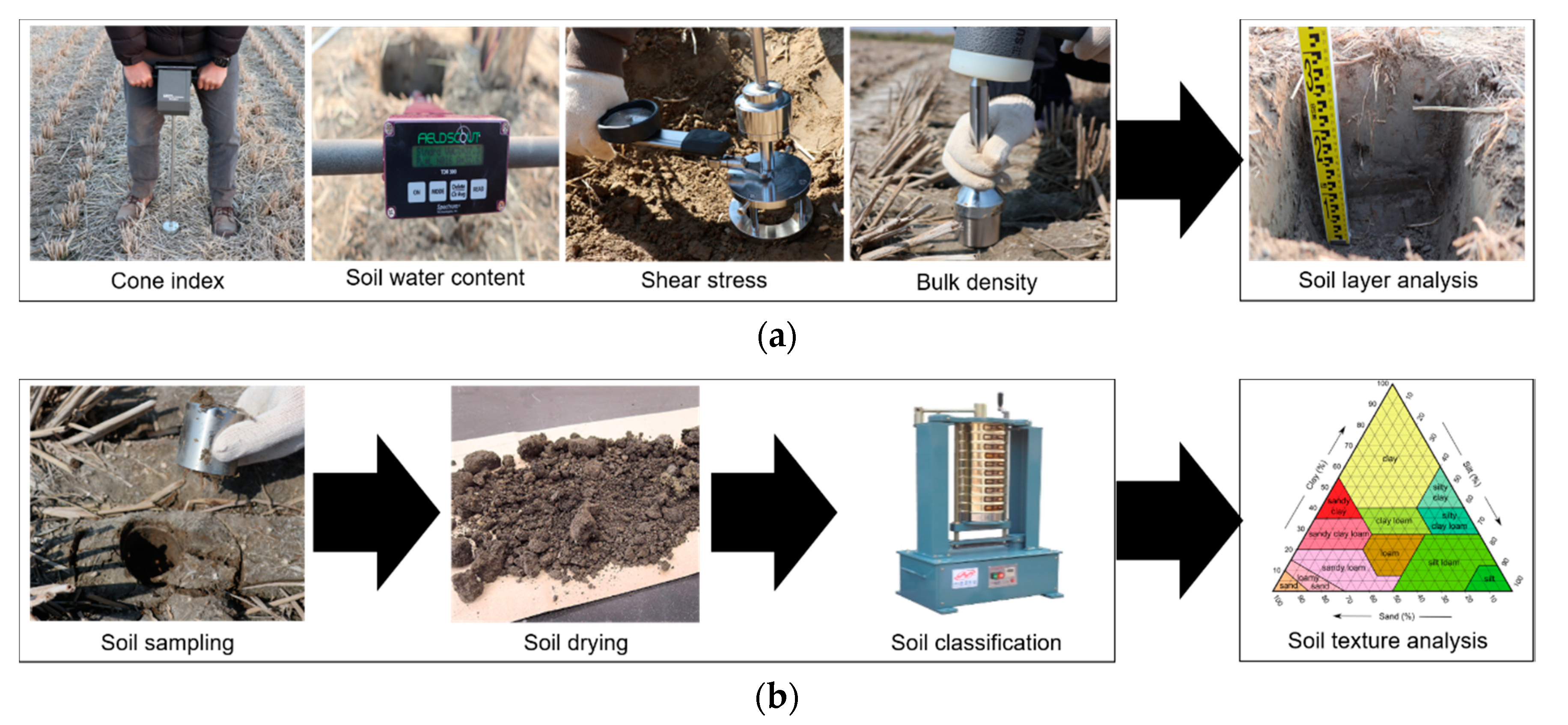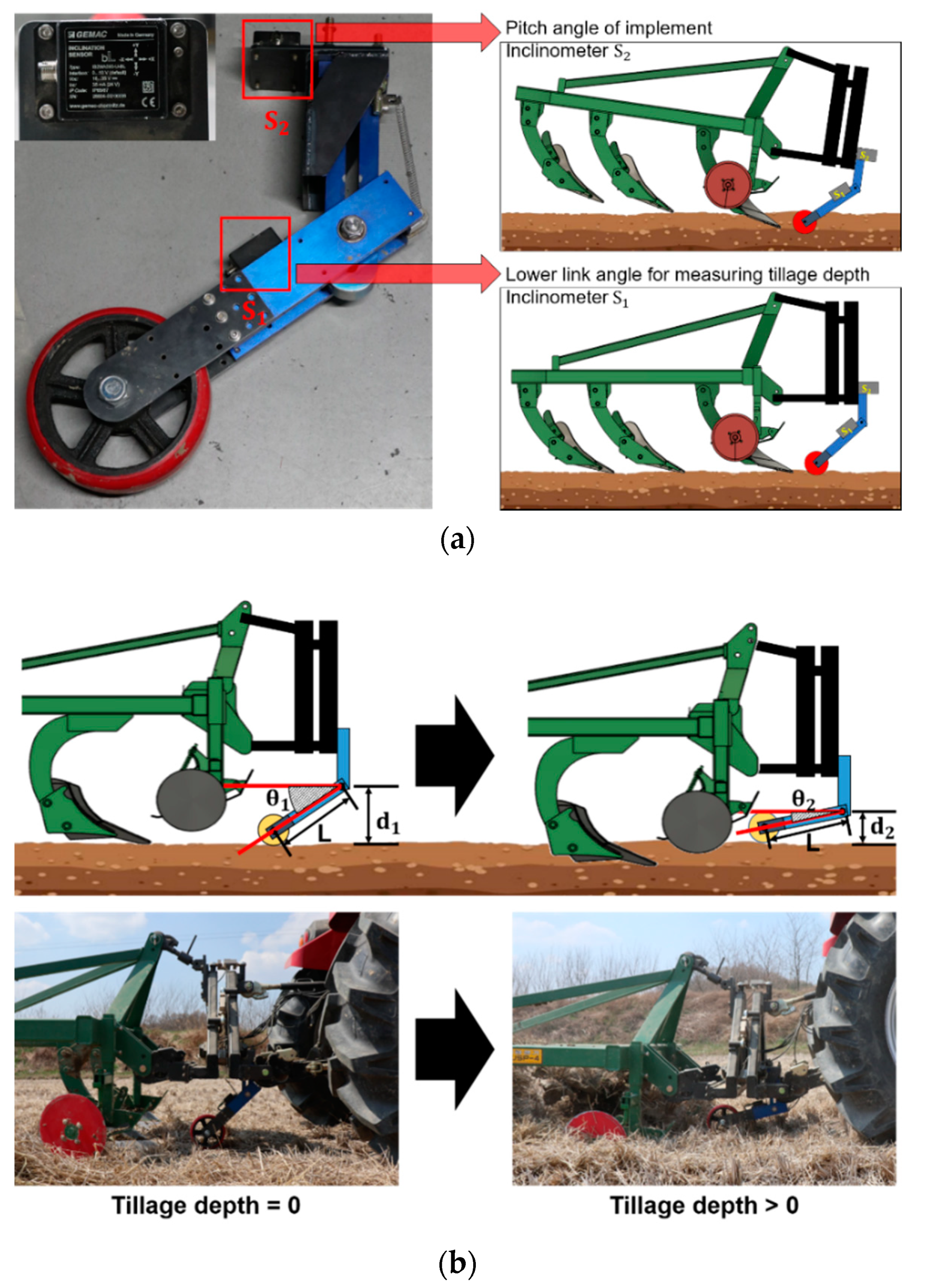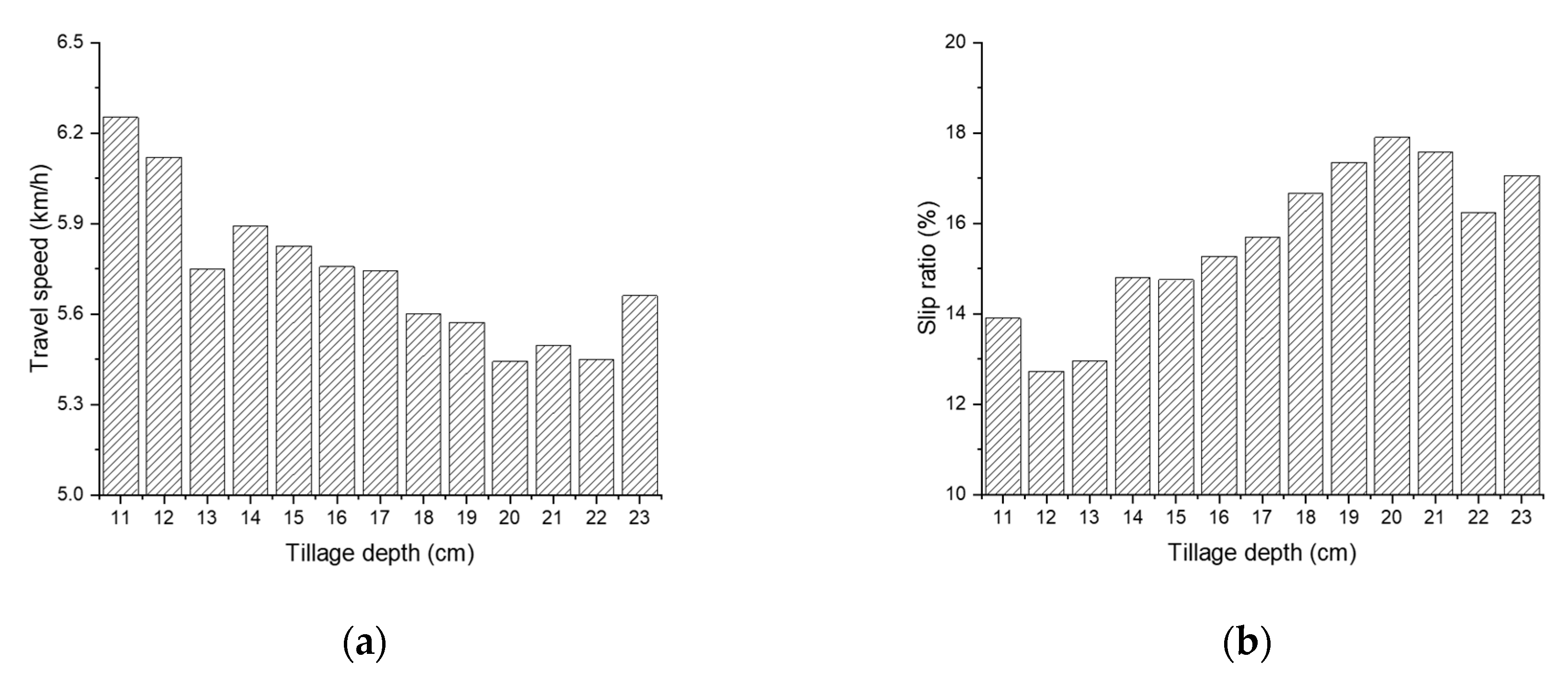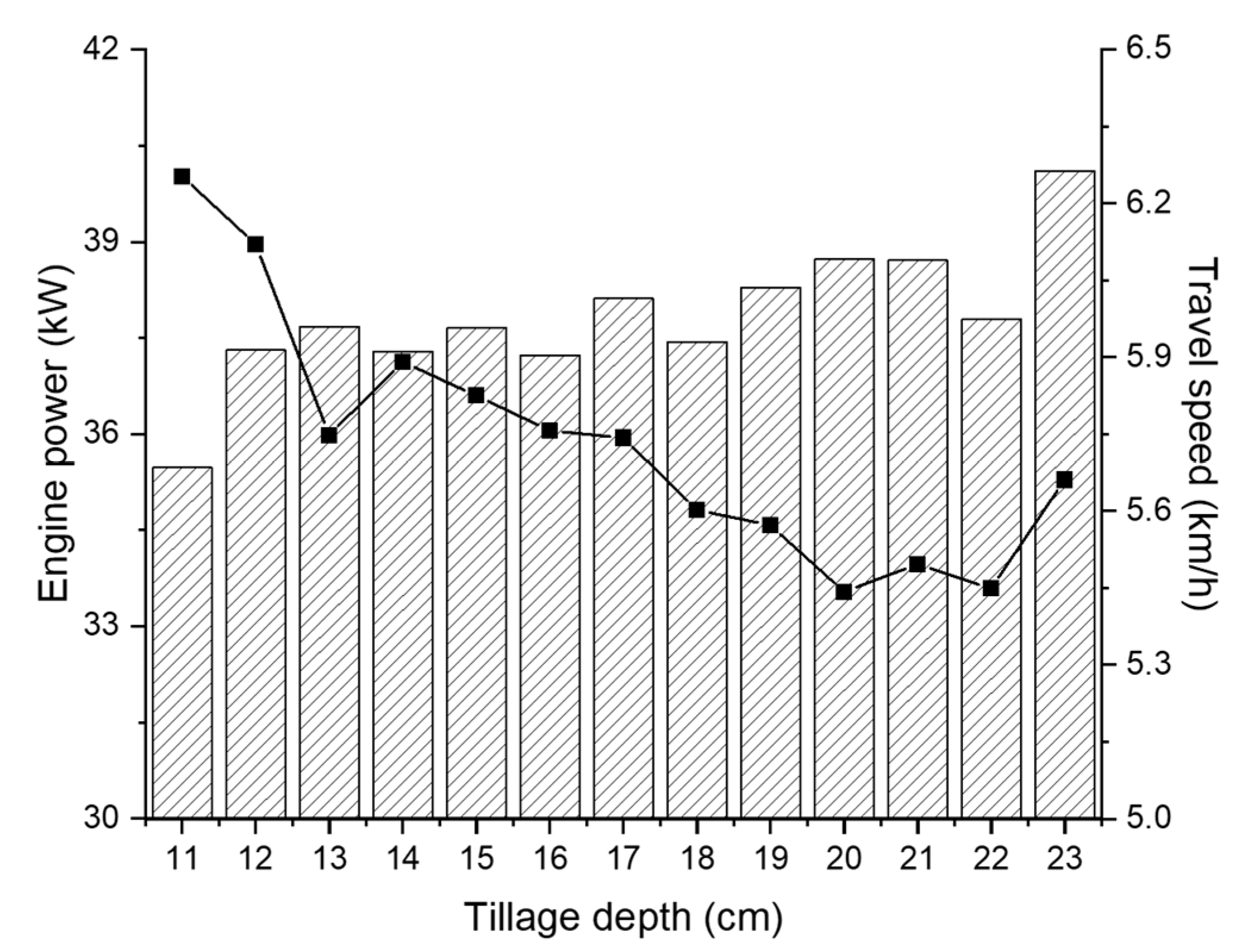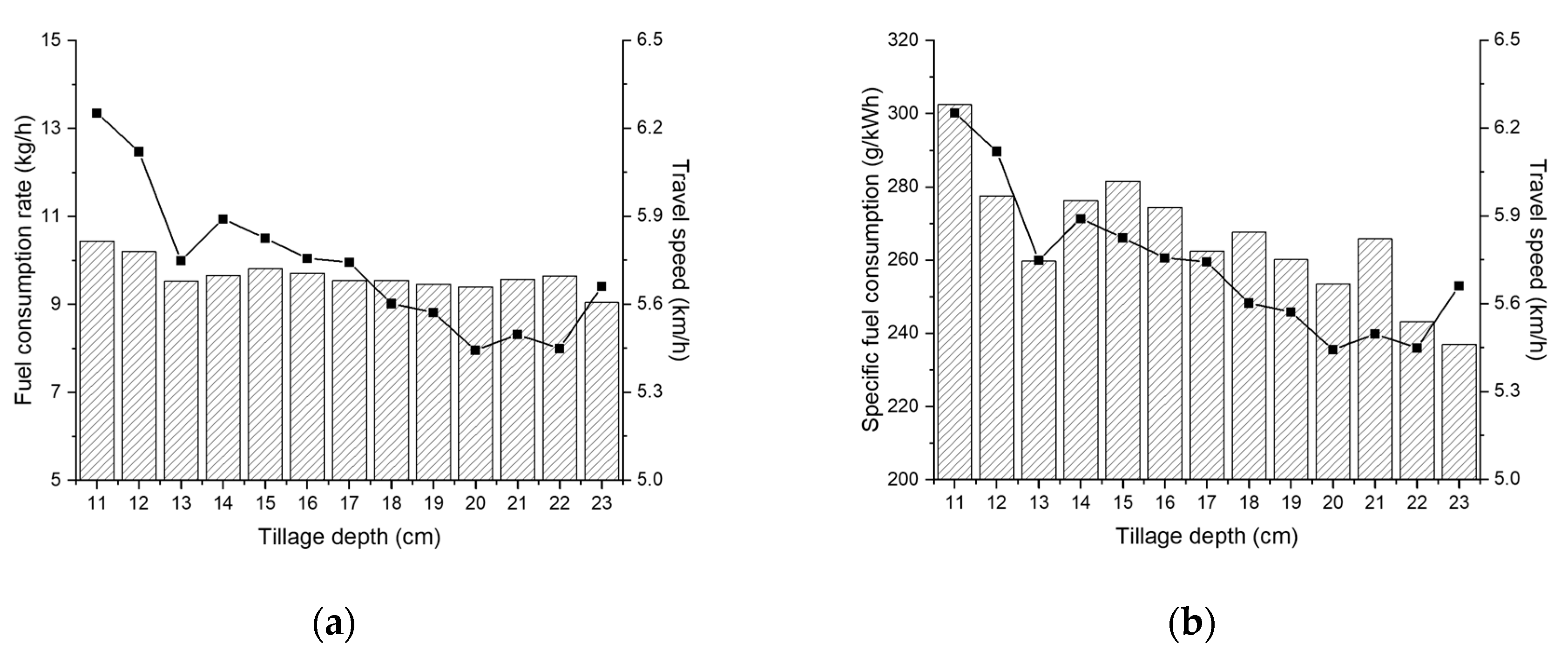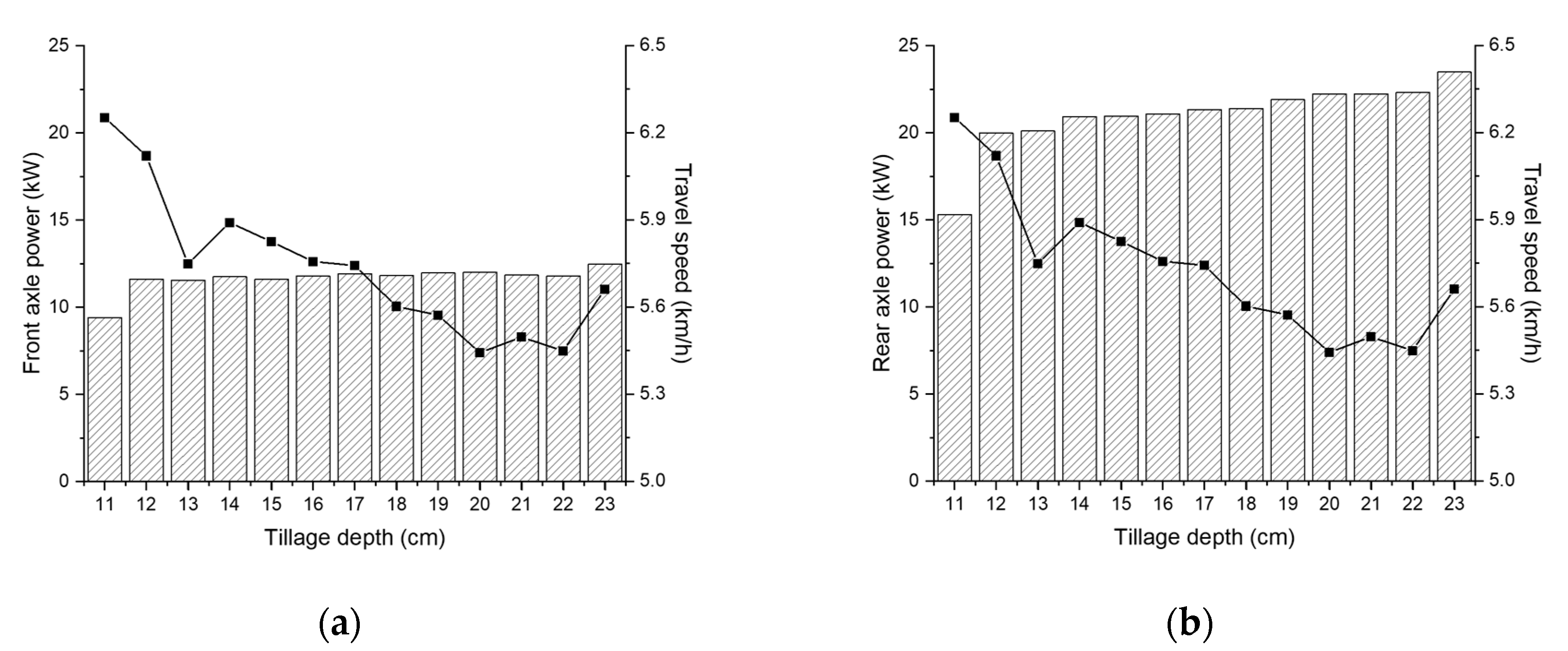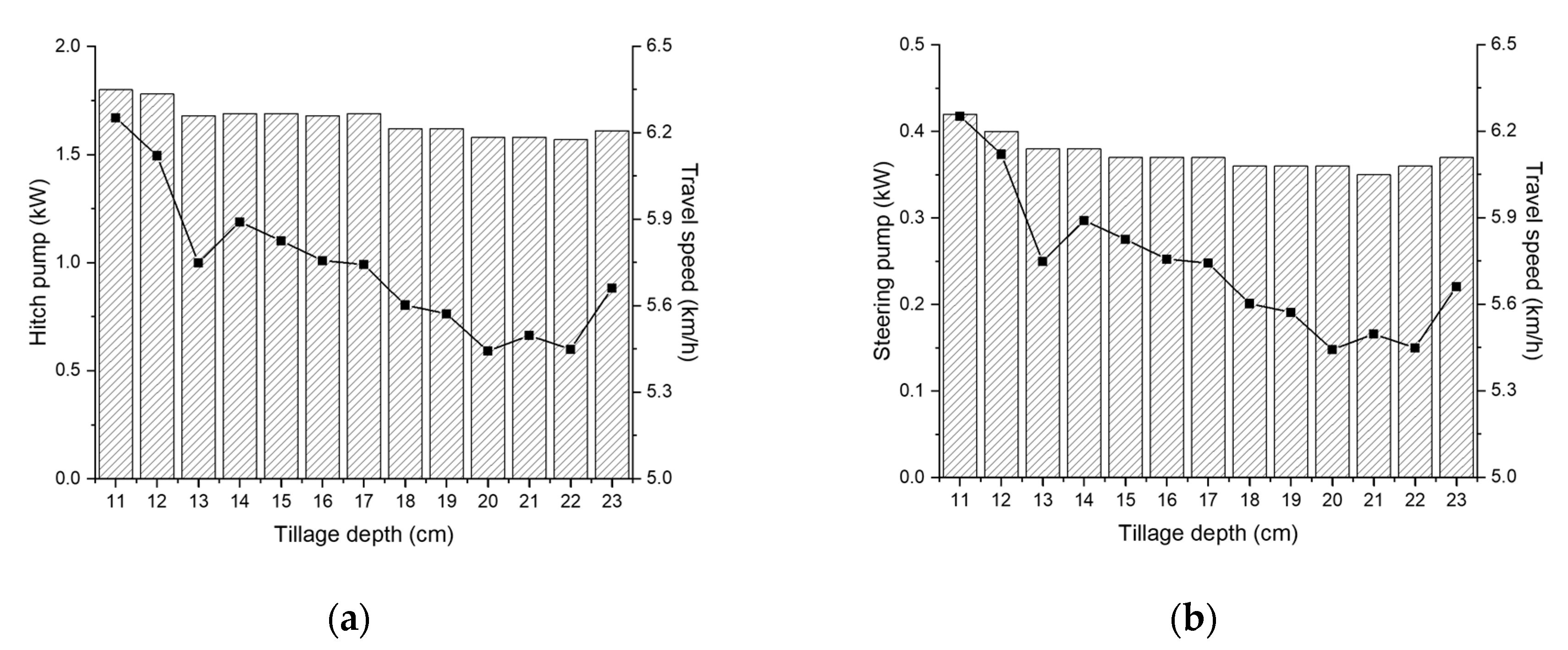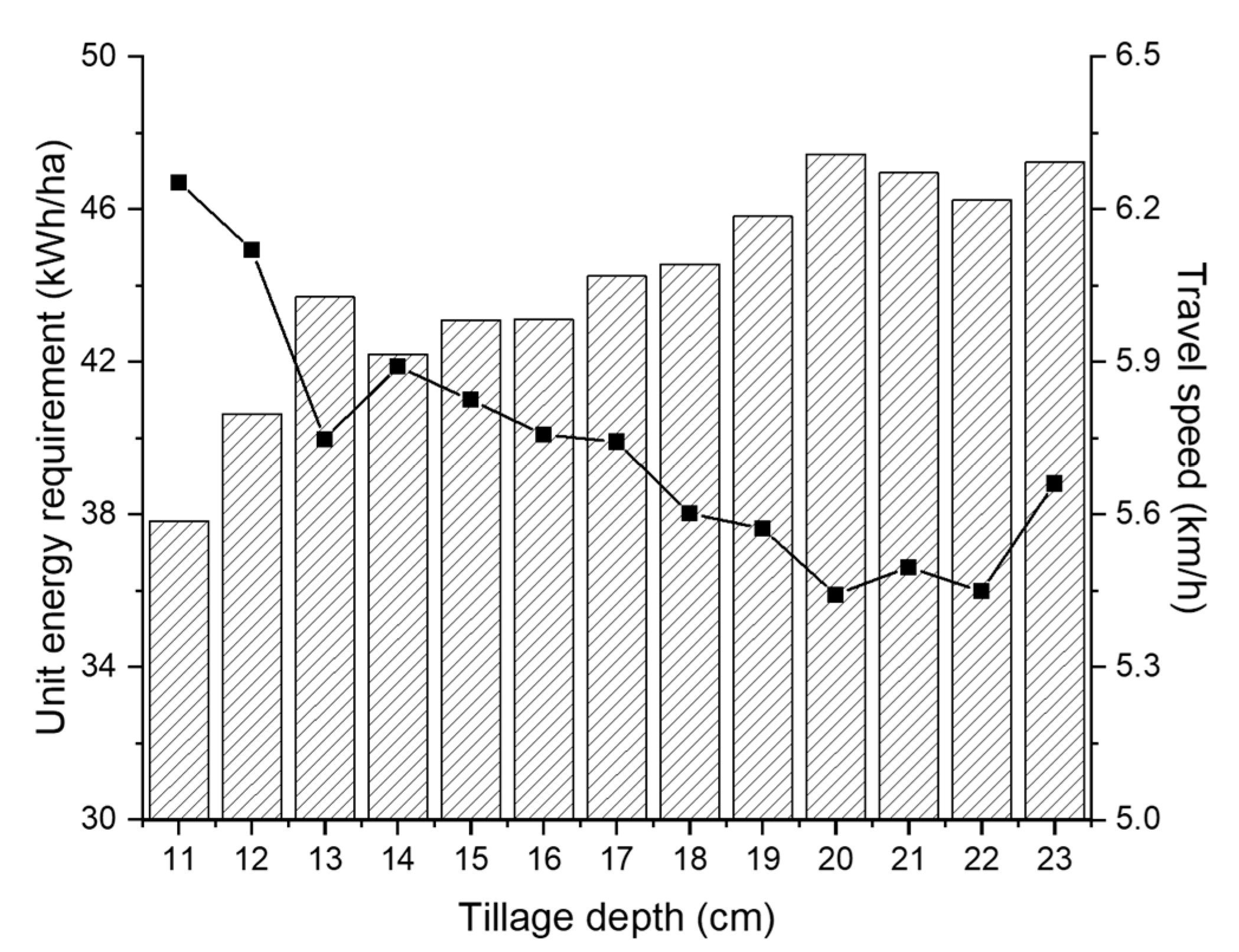1. Introduction
The global agricultural machinery market is increasing rapidly, with predicted market size expected to grow at a compound annual growth rate (CAGR) of 5% in 2017–2022 relative to 2012–2017. In particular, farm tractors account for the highest market share, at more than 35% of the whole agricultural machinery market [
1]. Therefore, optimal designs of agricultural machinery are urgently required to secure competitiveness in the growing global market [
2]. Power transmission systems are the most important components to consider when optimizing the design of parts that determine the performance and price of tractors [
3,
4,
5]. In particular, the tractor load is a key indicator of farming characteristics, so it is essential to analyze factors affecting the load [
6]. To improve tractor quality, it is necessary to analyze the working load of the tractor during operation. This is because its load characteristics are affected by various factors such as soil properties, operation type, traveling speed, gear selection, tillage implement shape, vehicle width, and tillage depth [
7]. Thus, an analysis of the load on agricultural tractors during field operation is important in order to achieve their optimal design [
8].
A field experiment was conducted to effect analysis of implement type (moldboard, chisel, disc) and travel speed depends on gear selection on the tractor performance during moldboard plowing [
9]; the experiment results showed that as travel speed increased draft force, slip ratio and drawbar power increased, but traction efficiency decreased. In addition, when a similar range of traction force occurred, chisel plow can perform at more than twice the travel speed compared to moldboard and disc plow. In another study, an experiment was carried out to effect analysis of soil moisture content, bulk density, and travel speed on energy requirement of agricultural tractor during disc plowing [
10]; the test results showed an increase in energy requirement with increasing bulk density and travel speed. In another study, the effect of the cone index on the work load of the 78 kW power agricultural tractor during moldboard plowing [
11]. The results showed that as the soil cone index increased, the wheel axle slip decreased by 18% and the draft force increased by up to 13%, affecting the engine torque by up to 9%. As above, factors influencing tractor load such as gear selection, implement type, moisture content, bulk density, and soil properties such as cone index have been investigated. In another study, the effect of deep tillage using moldboard or chisel plows on crop productivity of corn was analyzed; the results showed that it was proved through field tests that the use of moldboard or chisel plows affects the increase in crop yield of corn by more than 11% compared to production through no tillage [
12]. However, no studies have been conducted on how changes in the instantaneous tillage depth that occur continuously during tillage affect the tractor load and power transmission efficiency.
Some studies relating to the power requirements of agricultural machinery have been carried out with agricultural tractors. The field test using an underground crop harvester attached to a tractor was conducted to analyze the power requirements according to transmission gear selection during tractor operation [
13]; the results showed that the required power of the wheel axle increased by 34% at a high traveling speed. The power requirement and fuel consumption of tractor were analyzed in disc harrow systems [
14]; the results showed that fuel consumption during the tillage operation can be minimized by selecting an engine speed that is approximately 70%–80% of the rated speed. Tillage depth has a considerable influence on the mechanical aspects of a tractor such as its load and required power [
15]. In addition, because tillage depth affects the agricultural ecosystem (soil-water-crop relationships), it can impact crop yield and quality [
16]. Therefore, tillage depth is a key factor that must be considered from the perspective of both agriculture and agricultural ecosystems. Although some studies have been conducted to calculate the power requirements according to the operation type or gear selection, factors related to soil mechanics such as tillage depth and soil properties have not been investigated.
Several studies on the tractor load have considered tillage depth of tractor implements. The influence of traveling speed and tillage depth on chisel plow operation has been analyzed [
17]. In a study on the influence of tillage depth, penetration angle, and forward speed on the soil/thin-blade interaction force, it was found that both penetration angle and tillage depth had a greater impact on the interaction force than the forward speed [
18]. The energy requirements of a tractor have been analyzed in terms of the cover crop (none or rye), depth of tillage (shallow or deep), seasonal tillage timing, and soil compaction during cotton yield operation [
19]. However, in these studies, because tillage depth could not be accurately measured, only the effect of random tillage depth was analyzed, and the approximate measurement of tillage depth was made by manual measurement. In addition, since it was not possible to measure the tillage depth in real time during tillage operation, some studies have been conducted in an indoor soil bin [
20,
21]; however, in this environment it is difficult to consider the soil properties of hardpan, one of the representative properties of soil where tillage operations are performed. Repeated use of large farm machinery, such as agricultural tractors, results in the formation of hard plates at the bottom of the plow layer, by compression of the soil surface [
22]. These hard plates are called hardpan, which leads to poor drainage and poor crop growth [
23,
24,
25].
Tillage operations with an agricultural tractor have a significant impact on crop growth and yields [
26]. Paddy fields that grow rice are composed of two types of soil layer; the plow layer and the subsoil layers. The plow layer is the depth of soil that is target for annual or periodic cultivation using an agricultural tractor. The plow layer is usually at a depth of 5–25 cm beneath soil surface, and it is often greatly worked through tillage operation, fertilizer addition, irrigation, and crop cultivation [
27,
28]. The specific target tillage depth should be considered to prevent a hardpan layer forming in the plow layer. Therefore, it is very important to measure the formation depth of the hardpan and set the tillage depth appropriately.
Many studies have been carried out which consider soil properties, type of operation, and seasonal conditions. An analysis of the above literature related to power requirements and tillage depth confirmed that tillage depth has the greatest impact on field operation. The draft force generated between the soil and the attached tillage implement ultimately has the greatest influence on the power requirement of the tractor, which is mainly defined as a function of the implement width, travel speed, and tillage depth [
29]. Nevertheless, there has been no consideration of depth measurement methods for precise analyses according to tillage depth; further, a power requirements analysis has also not been conducted. In particular, since the tillage depth and soil properties greatly affect the load, power transmission efficiency, fuel efficiency, the decision support criteria, and fault diagnosis of the automatic transmission development system, which is one of the key areas of smart digital farming, which has recently become an issue in the agricultural machinery research field. Therefore, it is necessary to study the effect of tillage depth on the power transmission of tractor during tillage operation.
The purpose of this study was to analyze the power requirements of an agricultural tractor during moldboard plowing at different tillage depths. The specific objectives were (1) to develop a measurement system for power requirements and tillage depth, (2) to measure a power requirements and fuel consumption during moldboard plowing, and (3) to analyze the effect of tillage depth on power transmission efficiency of an agricultural tractor.
2. Materials and Methods
2.1. Agricultural Tractor and Plow Implement
The specifications of the agricultural tractor used in this study are listed in
Table 1, and the performance test for general certification was conducted at FACT (Foundation of Agri. Tech. Commercialization & Transfer, Iksan, Korea). A 42 kW power agricultural tractor (TX58, Tong Yang Moolsan, Gongju, Korea) was equipped with mechanical transmission and had a total mass of 3606 kg including attached plow implement, loader, and the data acquisition system. The tractor transmission was of a power shuttle and power shift type. The 24 forward and 24 backward traveling speeds can drive up to 33.8 km/h by a combination of gear setting according to operation type. In this study, a four-row moldboard plow (WJSP–4, Woongjin Machinery, Gimje, Korea) was used to match the power of the 42 kW power tractor engine as shown in
Table 2. Moldboard plows are widely used in Korean paddy fields. They are superior to other plow implements in terms of stability; however, they have a large traction resistance [
30]. The agricultural tractor and attached implement used in the field experiment are shown in
Figure 1.
2.2. Measurement of Soil Properties
Analysis of soil properties such as cone index, soil moisture content, soil shear strength, bulk density, and soil texture, which affect the interaction between soil and machinery is essential [
31]. In order to analyze the effect of tillage depth on tractor power requirements and fuel efficiency, soil properties according to soil depth were measured. Cone index is the force required to penetrate using a circular stainless-steel cone on a cone penetrometer (DIK-5532, Daiki Rika Kogyo Co., Ltd., Saitama, Japan). Soil moisture content is the quantity of water contained in a soil and is measure using a soil moisture sensor (FieldScout TDR350, Spectrum Technologies, Aurora, IL, USA). Soil shear strength (kPa), which is soil resistance torque that occurred soil failure by soil resistance meter (DIK-5503, Daiki Rika Kogyo Co., Ltd., Saitama, Japan). In particular, the cone index is important data for identifying the depth of hardpan formation that affects soil impermeability and porosity [
32], and soil shear strength is a soil property that directly affects the tractor load and has been repeatedly measured more than 30 times respectively [
33,
34]. In addition, soil samples were taken for soil texture analysis, and soil particle distribution was analyzed using a soil particle classification machine (HJ-2152, Heungjin, Gimpo, Korea). Soil texture was defined using USDA soil classification standards [
35].
Figure 2 shows the specific test procedure used for measuring soil properties.
where
is the shear strength of soil (kW), T is the soil resistance torque,
is the outer radius of circular shear ring,
is the inner radius of circular shear ring, SE is the surface energy of soil (
), and
is the soil contact area of soil resistance meter used to measure soil shear strength in this experiment.
where
is the bulk density of soil (
),
is the weight of sampled soil (kg), and
is the volume of stainless soil sampling tube (
).
2.3. Load Measurement System
The power requirements (engine, wheel axle, and hydraulic pump) and fuel efficiency were measured using a load measurement system as shown in
Figure 3a. In addition, the overall power flow in the tractor system is shown in
Figure 3b.
The engine part of load measurement system is configured to measure the engine torque, engine rotational speed, and fuel consumption, which is the average time that farming operation is possible per unit quantity of fuel. A telemetry type stain gauge was installed directly on the flex plate, which is a metal disk that connects the output from an engine, to measure engine torque. The engine rotation speed required for calculating the required engine power was measured through wireless controller area network (CAN) communication. In addition, the engine fuel consumption was measured by installing an oval gear flowmeter (OG2-SS5-VHQ-B, Titan Enterprises, Sherborne, UK) with a measurement capacity of up to 4 L/min at the input and output terminals of the engine fuel supply line, respectively.
The wheel axle part consisted of a flange type torque meter (PCM16, MANNER, Spaichingen, Germany) and a hall effect gear tooth speed sensor (CYGTS211B-PO2, Chen Yang Technologies GmbH & Co. KG, Finsing, Germany) were used to measure both the torque and rotational speed of the wheel axle. A torque meter and gear tooth speed sensors were installed on each of the four axle shafts; one antenna for each torque meter is attached to the outside of tire wheel. The axle torque data from each torque meter were amplified by internal amplifiers and transmitted wirelessly to a stationary antenna, then transmitted to the controller along a cable line. The nominal load of the torque meter was 20 kNm, the maximum load was 400%, and the sensor was a strain gage type. The sampling rate was 4 kS/s, the maximum axle rotation speed was 4000 rpm, and the operating temperature was in the range of 40 to 125 .
The hydraulic part consisted of a hitch pump and a steering pump. The hitch pump was used to control the front loader and rear 3-point hitch, and the steering pump was used for tractor steering, PTO (power take-off), and braking. A pressure sensor (PTD, Sensys, Ansan, Korea) was used to measure the hydraulic output of the steering pump and the hitch pump. The pressure sensor has a pressure measuring range of 100 kPa to 150 MPa in the range of 20 to 80
. The following equations were used to convert the measurement data obtained from each sensor of the load measurement system for power requirements analysis.
where
is the power requirements of the engine (kW),
is the engine brake torque (Nm), and
is the rotational speed of the engine (rpm).
where
is the power requirements of the wheel axle (kW),
is the wheel torque (Nm) obtained from the torque meter, and
is the rotational speed of the wheel axle (rpm) obtained from gear tooth speed sensors.
where
is the power requirements of the hydraulic pump (kW), Q is the flow rate (L/min), and P is the pressure (bar) obtained using a pressure sensor.
where
is the fuel consumption of engine (L/min),
is the flow rate (L/min) measured by flowmeter installed on the fuel input side of the engine,
is the flow rate (L/min) measured by flowmeter installed on the fuel outlet side of the engine, and
is the specific fuel consumption (g/kWh).
The travel speed and slip ratio are one of the main parameters that have a great influence on the power requirements of the agricultural tractor [
36]. In general, to keep the traction performance constant, the tractor must be able to reach a sufficient travel speed during agricultural operation. Therefore, the travel speed and slip ratio were important parameters in determining power requirement of agricultural tractor. A real-time kinematic global positioning system (RTK-GPS) sensor (GPS1000, Swift Navigation, San Francisco, California, USA) was attached to the center of gravity of the tractor to measure the precise speed and slip rate of the tractor.
The following equations were used to calculate theoretical speed and slip ratio obtained from related sensor for effect analysis on power requirements of agricultural tractor [
37,
38].
where V
tire is the theoretical speed of the agricultural tractor (km/h), D is the diameter of the wheel (m), N
wheel is the rotational speed of the axle as obtained from proximity sensors (rpm), and GR is the gear ratio at the selected gear.
The slip ratio of the agricultural tractor was obtained using the following equation:
where S is the slip ratio of the agricultural tractor during tillage operation (%),
is the travel speed of the tractor obtained from the real-time kinematic GPS sensor (km/h), and V
wheel is the theoretical speed of the tractor considering wheel diameter and wheel rotational speed obtained from Equation (9) (km/h).
In addition, in research related to agricultural machinery, it can be said that the draft force between the attachment plowing implement and the test soil directly affects the tractor load and power requirements according to the travel speed and slip ratio. In this field experiment, a commonly used six-component load cells system was used to measure the draft force [
39,
40]. The six-component load cells system consisted of six tensile compression-type universal type load cells (UU-T2, DACELL, Cheongju, Korea) to measure the 3-axis forces (horizontal, vertical, and lateral) that occurred during tillage operation. The tensile compression-type universal load cell used in this study has a rated capacity from 2 kg to 10 ton-force and the operating temperature was in the range of—20 to 80 °C, which is suitable for harsh tractor field test environments. In six-component load cells system, three load cell values for draft force, which means horizontal force occurred during moldboard plowing, are considered [
41]. The draft force was obtained using the following:
where D (kN) is the draft force; F
a, F
b, and F
c are the forces (kN) measured from the load cells attached to the triangular frame edges of the six-component load cell system during moldboard plowing.
2.4. Tillage Depth Measurement System
In order to analyze the effect of tillage depth, which is one of the most influential factors on mechanical load of agricultural machinery such as draft force, wheel axle load, engine load, and slip ratio, several studies on the development of real-time tillage depth measurement systems have been conducted [
40,
42]. In this field experiment, shortcomings (universality, durability) of the tillage depth measurement system developed in previous studies were improved and used for field experiment. Tillage depth was measured using two inclination sensors (IS2MA090-U-BL, GEMAC sensors, Chemnitz, Germany) attached to a self-designed jig. The sensor is IP67 degree of protection rated for harsh tillage environments and in the temperature range of—40 to 80
; the angular information on the two axes shows an accuracy of ± 0.1°. One inclinometer sensor (
) was attached to the lower jig of the tillage depth measurement system and was used to measure the angle occurrence according to the vertical penetration depth that occurs when the attached implement penetrates the soil. Another inclination sensor (
) was attached to the top of the lower link of the three-point hitch connecting the work machine and was used to check the jig generated during the operation and the angle of twist of the x and y axes posture of the implement and measure the pitch angle. The experimental configuration of the tillage depth measurement system is shown in
Figure 4a. The principle of measuring the vertical penetration depth of an actual implement through a tillage depth measurement system is shown in
Figure 4b. If the tillage depth occurs among the moldboard plowing, the angle formed by the lower link with the surface parallel to the soil surface is drastically reduced compared to when the tillage depth is zero, resulting in a change in the angle of incidence. At this time, tillage depth is calculated by considering the change in the angle between them. The tillage depth was obtained using the following equation [
40,
42]:
where TD is tillage depth (cm) of the moldboard plow, L is the length of the lower link of tillage depth measurement system (mm),
is the angle measured using the inclination sensor (
) when lower link is rotated from an angle parallel to the soil surface when the tillage depth is zero (deg),
is the angle measured using the inclination sensor (
) when the tillage depth occurs (deg),
is the vertical distance from the soil surface to the joint when the tillage depth is zero before moldboard plowing,
is the vertical distance from the soil surface to the joint when tillage depth occurs after moldboard plowing begins.
2.5. Field Experiment
Field experiments were conducted in Kumam–ri, Songsan–myeon, Chungcheongnam–do, Korea, which is a rural area. The area of the test site is 100 × 80 m, and its latitudinal and longitudinal coordinates are 3655′48″ N and 12637′59″ E, respectively. First, soil properties, which have a significant effect on tractor load, were measured repeatedly. The field test was performed by operating the tractor in four–wheel drive mode and M3 gear stage, which are commonly used to perform moldboard plowing in rural areas. In order to exclude the gear selection effect and to analyze only the tillage depth effect on tractor power transmission efficiency, the field test was repeated three times in the M3 gear selection on the hard pan, the area where soil compaction occurs. Furthermore, in order to minimize the influence of the weight distribution ratio by the front loader, field tests were performed under the condition of fixing at the maximum height that does not obstruct the view during moldboard plowing. To analyze the effect of tillage depth on the power transmission efficiency and fuel consumption rate of an agricultural tractor, the measured data were sorted in ascending order in 1 cm units according to tillage depth. In addition, statistical analysis was performed to determine whether tillage depth affects the power transmission efficiency of agricultural tractor.
4. Discussion
In general, the engine load level compared with the rated engine power proportionally reflects the performance of the entire tractor [
48,
49]. In addition, agricultural tractors and related field equipment use a lot of energy and time on farming operations. Therefore, it is important to find the optimum working efficiency conditions, considering parameters that have a significant influence on power transmission efficiency, such as tillage depth.
In this study, as a result of analyzing power requirements according to the tillage depth, statistically, all power requirements of major parts showed significant differences according to tillage depth. In the case of the hydraulic pump (hitch and steering pump), statistically, it showed a difference, but the power transmission efficiency of hydraulic pump had a very small quantitative measurement value, and compared with the engine power requirements, the hitch pump was 4% and the steering pump was 1%. In addition, power transmission of the front axle increased by 2% depending on the tillage depth. In particular, in the case of rear wheel axle, power requirement was about 3.5 kW and power transmission efficiency was up to 10%, which was analyzed as the most affected major part of agricultural tractor according to tillage depth. Power transmission efficiency in tractor major parts compared to engine power requirement was 66% at 11 cm and 95% power transmission efficiency at the deepest tillage depth of 23 cm. This is much higher than the typical tractor power transmission efficiency of 84%–89% [
50,
51]. Through this, it was confirmed that the increase of most power transmission efficiency is achieved by the increase of power requirements in the wheel axle. In particular, as the tillage depth increased from 11 cm to 23 cm, the engine power increased from 35.48 kW to 40.11 kW by about 13% or more, but it was confirmed that the power transmission in each major part increased significantly. The power transmission efficiency with respect to engine power requirements according to tillage depth is shown in
Figure 14.
These results show that the fuel efficiency increases as the specific fuel consumption tends to decrease rapidly from 302.44 g/kWh (11 cm) to 236.93 g/kWh (23 cm) as the tillage depth increased. This is considered to have shown a tendency that the power loss generated in the process of power transmission to the major part of the tractor engine power decreases from 16% (12 cm) to 5% (23 cm). Therefore, when analyzing the working efficiency of the tractor, it is considered that the fuel efficiency represented by power transmission efficiency and specific fuel efficiency according to tillage depth should be considered. In conclusion, it can be seen that the power transmission efficiency and the fuel efficiency increase as the tillage depth increased.
In addition, when analyzing the results according to the tillage depth from the viewpoint of the unit energy requirement, as the tillage depth increased 1 cm, the unit energy requirement increased by about 0.78 kWh/ha. The minimum unit energy requirement was 37.28 kWh/ha at 11 cm. The maximum unit energy requirement was 47.43 kWh/ha at 20 cm, and it was confirmed that the maximum difference was 27.2% depending on the tillage depth. The unit energy requirement of agricultural tractor according to tillage depth is shown in
Figure 15.
In general, when working with the same mechanical tractor in different soils with different soil mechanical properties, the tillage depth affects the power requirements of the tractor, but it has not been considered in this test. Therefore, in the future study, it is planned to conduct a comparative analysis study on the analysis of the tillage depth effect on the tractor work load in various soil properties such as cohesion, adhesion, internal friction angle, shear modulus, and so on.
5. Conclusions
The objective of this study was to demonstrate the effect of tillage depth on the power transmission efficiency and fuel consumption rate of a tractor by measuring these parameters simultaneously through system configuration. In this study, a load measurement system and improved tillage depth measurement system were proposed to measure tractor power requirements and tillage depth during moldboard plowing. The proposed system configuration was able to accurately measure power requirements and tillage depth during moldboard plowing.
As a result of soil properties, the average cone index of the rice paddy changed rapidly at a depth of about 11 cm (1038.84 kPa) and peaked at 23 cm (3384.5 kPa), which means that the average hardpan distribution depth was from 11 cm to 23 cm. The field test considered this result and set the target tilling depth to the hardpan layer, and field test was repeated three times to ensure reliability of the measurement data. The statistical analysis results showed that the tillage depth conditions had a significant effect on the power requirements of the engine, wheel axle, pitch pump, and the fuel consumption rate. The results of the field experiment show that the power transmission efficiency increased by 29% (from 66% to 95%) and fuel efficiency 21.7% (from 302.44 g/kWh to 236.93 g/kWh) of the tractor increased dramatically, despite a decrease in engine rotational speed decreased by 11.3% (from 2095.96 rpm to 1859.37 rpm) and travel speed decreased by 24.2% (from 6.02 km/h to 5.44 km/h) as the tillage depth increases during the moldboard plowing. In particular, the power transmission efficiency of the rear axle showed the highest increase rate of 21% (from 38% to 59%). Therefore, it was concluded that tillage depth has a significant effect on power requirement and fuel consumption.
Based on the results of this study, it is anticipated that in the future, moldboard plowing can be customized by setting an optimum tillage depth according to soil and crop growth characteristics. In addition, the specific fuel consumption rate and crop growth environment can be improved. Therefore, operator working on moldboard plowing using tractors should set the permissible tillage depth as deep as possible considering the soil and crop growth characteristics to obtain high power transmission efficiency of agricultural tractor.
In conclusion, tillage depth was shown to have an effect on the power requirements of a tractor during moldboard plowing, using the proposed measurement system configuration. Not only the power requirements of the main parts of the tractor but also the power transmission efficiency was greatly influenced by tillage depth. Overall, moldboard plowing in the same gear tended to result in higher power transmission efficiency and fuel efficiency at deeper tillage depths. Therefore, when analyzing the power requirements of the main parts of the tractor and the fuel consumption rate during moldboard plowing, it is necessary to consider the effect of precise tillage depth in cm unit.
In the future research, considering the effect of tillage depth on the power transmission efficiency of the tractor will be used as a judgment factor in the development of automatic transmissions system, failure diagnosis system, and work history recording system, in the core field of smart digital farming of off-road machinery.

